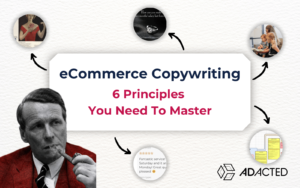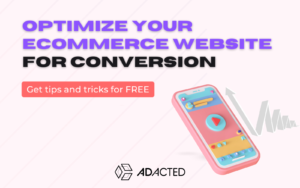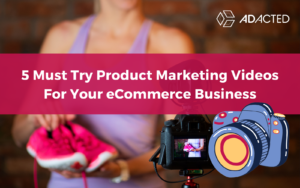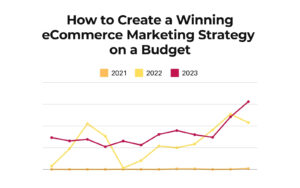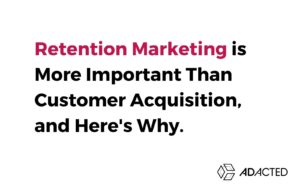Whether you’re an established eCommerce brand or just starting out, these marketing tips can help to improve your business. We have listed a wide variety of tips and strategies to help you get the most out of your marketing efforts. From building a compelling landing page, creating an effective offer, to developing a sound budget strategy for your campaign.
1. Determine your budget and set a realistic goal
The first step in eCommerce marketing is to determine your budget. This might be tricky if you are just starting out, but it’s important that you don’t spend more than you can afford on e-commerce marketing efforts. Determine what your eCommerce marketing budget is and set a realistic goal. Then, work backward to determine the best way to reach that goal within that budget.

2. Develop an eCommerce marketing strategy that focuses on your target market
eCommerce is all about reaching out to your target audience. Your eCommerce marketing strategy should be focused on building long-term relationships with potential customers and encouraging them to return for repeat purchases. eCommerce marketing is not just about getting people to buy your products, it’s also about maintaining the relationship with them over time. Here is how to develop your eCommerce marketing strategy.
- Know who you are selling to and write content that is relevant for them.
- Your eCommerce sites should be targeted at specific groups of people, not just anyone with an internet connection.
- Research the behavior of these people so you can tailor a unique experience for your target audience.

3. Conduct research on other similar businesses – competitors’ pricing, products, and offers
The eCommerce industry is very dynamic with constantly changing prices and offers. Researching what your competitors are doing will ensure that you’re not left behind when it comes to pricing, product offering, or promotional activities. Having this information will allow you to be proactive in eCommerce marketing instead of reactive.

Conducting research on eCommerce competitors’ pricing is important because it allows you to set your prices competitively, while still ensuring that the price point fits with the perceived value of the product or service being offered. For example, if your product is a similar, but slightly lower quality than the competitor’s product and their price seems to reflect that, then it would be wise to consider pricing your eCommerce product at or just below theirs.
Pricing research as part of eCommerce marketing also includes researching promotional activities such as discounts or coupons offered by competitors.
4. Create a mobile-friendly online store
Over 80% of traffic to eCommerce websites comes from mobile devices, including phones and tablets. Make sure your mobile site design looks great on any device by making it responsive – meaning the layout will adjust to fit screens of all shapes and sizes! You can work with a web developer, agency, or a specialized Saas online ordering provider that will help you create a mobile-friendly online store.

5. Ensure your site loads quickly and doesn’t have any errors in the code
Site load speed is one of the most important factors that search engine like Google consider when ranking eCommerce websites.

An online store that load in less than a second have a 53% higher conversions rate. Every additional second an online store takes to load, reduces conversions by 16%. Ensure that your online store is always optimized for speed and never has any coding errors by using a tool like GTmetrix to test it regularly.
6. Have an About Us page on your website for customer service and company information
Use this page to tell customers about your business. If you’re a startup eCommerce company, use the About Us page as a chance to show off who you are and what makes you different from other eCommerce websites. A good “About Us” page should be clear, engaging, and provide an opportunity for potential customers to get in touch.
Here is an example of a good About Us page design from Burton:

Go beyond the basics of what your business does by telling customers about who you are, why you started this company, and where you’re based. You could also use this page as a chance to show off the team. It creates a sense of trust and shows your website visitors that your company is real. One of the best tips for the About Us page is to include a map of your location, a photo of your team and founder, and your contact details.
7. Upload high-quality images of your products to make them stand out
A high-quality image will showcase your product in its best light and encourage visitors to purchase it. Make sure the images are clear, bright and show details of the products so that customers can really see what they’re buying.
Images should also be consistent(background colors, patterns, etc.) throughout the eCommerce store. If you use images of products on your homepage, make sure they are similar to what is visible in other areas of the site e.g., product page, etc.

8. Keep your website design simple and easy to navigate
It’s easy to get carried away and go overboard in the design apartment, but remember – the goal of the online store is for people to convert to paying customers.
For that to happen, your website needs to be easy to navigate. Make sure that people have a logical path from the home page all the way through the checkout process – for eCommerce websites this usually means as few clicks as possible!
If there are too many distractions your website visitors will abandon the purchase process before completing it.
According to research, the average shopping cart abandonment rate is 68.15%, meaning that nearly three-quarters of all eCommerce carts are abandoned before they’re completed.
Make your eCommerce website design simple and easy for customers to navigate by using tools like Usability Hub or Google Analytics Site.
One of the best eCommerce marketing tips is to Keep it Simple, Stupid(K.I.S.S. ).

9. Create a blog to attract new customers and drive traffic
By having an eCommerce blog, you can attract new customers and funnel traffic back to the site through search engine optimization (SEO). A blog is a great way to stay in touch with current customers and to make them feel like their voice is heard. You can use eCommerce blogs as a way to promote new or upcoming products, provide customer support by answering questions, share industry insights about your market space and keep readers updated on blog posts they missed from previous days/weeks.
Whatever you do, keep in mind that an eCommerce blog should be useful and relevant to readers.

10. Build a strong customer base by providing excellent customer service
Providing excellent customer service builds a strong customer base. eCommerce business owners who are able to provide top-notch support see their return rates increase, which results in creating stronger relationships with loyal customers. Furthermore, businesses that excel at providing great customer service notice an increased number of referrals and reports by satisfied consumers about the store they bought from. Word-of-mouth referrals are one of the best eCommerce marketing strategies that can get new customers, and providing great customer service is key in achieving this.
Realize that your eCommerce store is representative of you – Your eCommerce site represents who you are as a company.
Here are some tips for eCommerce business owners to provide excellent customer service:
- Be professional and friendly at all times.
- Actively listen to your customers – Sometimes it’s best just to shut up and let the customer speak.
- Link eCommerce automated messages software such as chatbots for customer service.
- Focus on providing one-on-one attention with customers.
- Respond to customer inquiries quickly.
- Be empathetic when dealing with customers who are frustrated or disappointed in your product/service.
- Offer something of value for free, but make sure it’s related to the eCommerce store itself.
12. Add reviews from happy customers on your website as social proof
People want to feel safe and secure when they are spending their money online. Having reviews from other customers that have previously bought the product reinforces this feeling of security as well as showing potential buyers how good your products or services really are.
It can also show you’re an established eCommerce business with experience in what you do which builds trust with the customer making them more likely to make a purchase off your website once they’ve read those positive reviews.

13. Optimize the content on your website to include SEO keywords
Optimize your eCommerce website content to include SEO keywords that customers are searching for in order to provide the best information and products about what they want, increasing online store sales in the long term.
- Optimize images on your eCommerce site with relevant titles, alt text, and file names.
- Include keywords in your meta description, since that’s what shoppers see when they do a Google search.
- Optimize the title tags on every page of your eCommerce site for eCommerce SEO.
- Optimize the eCommerce page headings and subheadings to include keywords.
- Include a sitemap that is accessible from your eCommerce site’s home page, which helps search engines index all of the pages on your eCommerce site more easily.
The best tools for SEO keyword research are Google Keyword Planner, Moz’s Free SEO tools, SurferSEO and SEMrush.

14. Reward customers for their loyalty
A customer loyalty program is a great way to keep people coming back to your eCommerce store. Whether you’re just starting out or have been in business for a while, implementing loyalty programs is one of the best marketing strategies to retain customers and build up customer trust.
Rewards should be tailored specifically to each individual brand as they will make them feel special and valued.
The best way is by implementing a rewards system in which they can accumulate points or cashback with every purchase.
Rewards can include :
- Free shipping
- Coupon codes
- Discounts on future orders.
- A ‘First Order’ bonus in which new members receive some type of reward
- Gifts
It is more crucial than ever for companies to find new ways on how they can keep customers coming back and stay a loyal customer as competition heats up between online stores in 2022 and beyond.
15. Add product reviews and customer testimonials from happy customers
Product reviews and testimonials are incredibly important eCommerce marketing tactics, as they allow you to gain credibility, trustworthiness and improve your conversion rates.
You can also cross-promote these testimonials on social media platforms and email campaigns as it would encourage more customers to leave their feedback about your products.
Use eCommerce product review plugins such as Yotpo and eKomi to allow customers and clients to leave their feedback, opinions about your products.
When using eCommerce product review plugins also consider adding Call-To-Actions (CTAs) for social sharing and email subscription as this would help you build a better community around your brand and improve visibility on search engines such as adding a product review section on your eCommerce website.
You should also consider adding customer testimonials from happy customers to the product pages, this will encourage more people to buy and let other potential customers know the benefits of using the products or services you offer.
A study revealed that 79% of consumers read online product reviews to inform their purchase decision.
Furthermore, 82% trust them as much as personal recommendations.
16. Maximize customer experience and reduce lost online sales from abandoned carts
Use your store’s analytics to determine the factors that are causing shopping cart abandonment. Once you know what is happening, it will be much easier for you to implement changes in order to minimize customer drop-off rates when abandoned cart emails are sent out.
Here are 5 ways to reduce abandoned carts:
- Offer free returns to encourage online shopping
- Use more images on product pages
- Add a reminder pop up with eCommerce software.
- Allow users to save items in the cart and come back later for them.
- Reward customers with loyalty points or a reward program
- Show shipping and returns info clearly on the product and cart page.
- Show customer reviews on the product page and in checkout
17. Engage with people on social media to build relationships and increase customer loyalty
eCommerce marketing is all about gaining and maintaining your e-commerce customers’ loyalty. In the e-commerce world, margins have been contracting at a rate of between 20 and 25% per year for the last decade. A key driver in keeping your e-commerce business profitable and growing is by building customer loyalty.
18. Offer referral programs
Your current customers are already in love with you, so they will provide the best referral marketing candidates to grow your eCommerce business.
When offering a referral program make sure to incentivize people well enough that it is worth their time but not too much that it encourages bad behavior or unethical acts like using bots.
You can offer discounts when someone signs up under the person who referred them and/or also gives away free products once certain sales goals have been reached.
If you don’t want to spend money on giving out prizes then ask users if they would be willing to do some type of social sharing.
Some good Shopify apps for referrals are ReferralCandy and GrowthDot.
19. Create landing pages for specific campaigns or offers
Marketers can create landing pages for campaigns that are either time-limited or have a specific, clear offer.
Marketers should consider including essential elements on landing pages such as:
- A clear headline that tells site visitors what action you want them to take
- A compelling call-to-action (CTA) button with a copy that explains why users should click through
- Product images and descriptions that showcase your product in detail
- Social proof icons like testimonials from clients who have purchased the item before
- Bullets points under each feature image explaining key benefits of purchasing your product
The most important aspect of any eCommerce landing page is to direct the user’s attention towards the desired objective so they do not get distracted by other details on your site.
20. Offer free shipping on orders over X amount – incentivize customers to spend more money with you
A free shipping offer is a great incentive for your customers to spend more money with you. If they are spending $30 – $40 in order, the free shipping incentive will convince them that it is worth buying another item or even two more items just because of free shipping.
TIP: Create a pop-up window on every product page which shows up after the customer has added at least one product to the cart. This pop-up should clearly display “free shipping” for the customer if they spend over X amount. If you are using an eCommerce platform like Shopify, this can be easily done with help of an app like eCommerceFuel.
21. Offer bundle discounts to increase average order value
Bundle eCommerce discounts are a great way to increase the AOV of your online shop.
This is done by adding an additional (relevant)product or accessory to the main purchase.
For example, if someone buys jeans from your eCommerce store you can offer them some t-shirts with their order at a significant discount.
Another method of bundling is simply throwing in a gift product along with the main order. Sometimes the best bundle discounts are based on the exact same product – for example, giving 30% off for the extra 2 (main)products in the cart.
A study shows that eCommerce conversions from bundle discounts can increase by as much as 50%! So it makes sense to start offering bundle discounts as soon as possible.
22. Be consistent with your branding across all channels
One of the hardest things to implement in terms of branding is consistency across all ecommerce marketing channels – on Facebook, Instagram, Tiktok, Google, Email, Landing page, and so on. This is where marketing can become tricky.
eCommerce businesses are usually divided into categories e.g fashion, food, sports, etc, and then depending on the category, there is a style of branding that will work best.
For example:
– Fashion eCommerce brands shouldn’t use bright colors in their ads
– Food eCommerce brands should not go for a dark theme or heavy imagery
– Sports companies should use bright, high energy colors
Here are 5 key metrics to be consistent in branding:
- logo
- shapes and colors
- tone of voice
- background imagery
- copywriting style
23. Use influencer marketing to your advantage
Influencer marketing continues its upward trajectory, and online businesses are jumping on this marketing opportunity. In order to be successful, eCommerce marketers need to understand that influencer marketing is very different from other types of social media marketing efforts.
Here are some tips for influencer marketing:
* Start by building relationships with key industry experts and leaders
* Use influencers that align with your brand identity
* Find influencers that have already promoted similar products or services
* Make sure they have an engaged audience (not bots)
* Utilize micro-influencers at the beginning and build up to bigger ones over time
* Use influencers to promote product launches
* Be transparent with your process and what you expect from each other
* Don’t just rely on one marketing channel or influencer, experiment with new ones

According to Mediakix, 80% of surveyed marketers find influencer marketing effective.
Influencer marketing is not a trend that will go away anytime soon.
eCommerce marketers who want to stand out from the crowd should be building relationships with influencers that align with their brand identity and using them as part of a larger marketing strategy.
24. Create A Slogan – a clear, concise message that is unique to your business
Slogans in branding help you separate from your competitors and make a statement about who you are as a business. Generating unique, short marketing messages is part of the branding strategy that will help customers identify your eCommerce store from others.
Examples of great marketing slogans:
“Just Do It.” – Nike
“Don’t Leave Home Without It.”- American Express
25. Use email marketing to re-market to the existing customers
Re-marketing is a form of marketing that can be used to reach out to potentially interested customers. In many cases, this could include people who visited the store’s website but did not make a purchase.
Marketing experts recommend a “nurturing” approach, which involves sending emails at regular intervals after the initial outreach until an interested customer makes a purchase or engages with you in some way. Email marketing or re-marketing is a great opportunity to generating sales from existing customers(or people who have subscribed to your list).
26. Leverage user-generated content – highlight customers photos and video testimonials on Social media
Leverage UGC (user-generated content )to demonstrate your eCommerce business’ value proposition by highlighting testimonials on social media, including in newsletters, featuring reviews of products on product pages, and even using the same photos and videos in your Facebook ads.
The benefits of using UG content are that it is low-cost, authentic, and real.
Many eCommerce businesses rely on their customers to share photos and videos on social media, while others have dedicated pages where users can upload customer reviews or testimonials about the products they purchased.
In some cases, eCommerce companies may even provide an incentive for user-generated content by offering a discount in exchange for reviews, free shipping, or gifts.
27. Cross-sell and up-sell to increase AOV(Average Order Value)
You can think of upselling as an upgrade to the existing purchase when CS(cross-selling) is an additional purchase to the original order.
Both are easy ways to increase sales.
A perfect product for CS is something that is frequently bought with the original product or complementary to it. CS is usually done on the bottom of the product page with a title similar to “You would also like” or “customers have also bought”.
For example, CS products that are frequently bought together e.g. batteries with the product you just sold e.g. digital camera.
Upselling is similar but in this case, instead of adding products to the cart when someone buys something, you wait until they have added their original item to the cart and offer them another product that is on the same level but more expensive.
Upselling is offering customers products that are more expensive than what they were originally looking for but still related to the original product or service.
An example of a upsell for a laptop would be a premium brand laptop e.g Dell or Apple instead of a standard(cheaper) one e.g Asus, Acer, etc.
The aim is to offer products at the same price point but with more features to convince customers that they are getting better value for their money and therefore should spend just a little bit extra on the upgrade.
Here are the usual spots on the website for cross and up-selling:
- product page;
- checkout page;
- thank-you page;
Remember, the key to upselling and cross-selling is to make it seem like the idea of purchasing a better product was theirs all along.
28. Consider using video marketing for maximum customer engagement
Video marketing will be among the most important digital marketing strategies in 2022 to increase product sales and brand awareness for businesses of all sizes.
There are many reasons why marketers should consider using video content for their digital strategy with eCommerce:
- eCommerce consumers prefer video content (80% of consumers say that videos help them make better purchasing decisions)
- Increase sales by 85% or more
- Video content gets shared 4X times more than other types of media
- Video is an easy way to engage your eCommerce customers.
- Video content is easy to share and can reach a wide audience, which brings in more traffic for you.
- Video marketing provides an opportunity to provide educational and entertaining information about products eg.” How To Videos”, without directly selling to the customer.
- You can showcase the entire product or service experience with video marketing, so potential buyers understand what they are getting before making their purchase decision – this will lead to higher eCommerce conversion rates.

29. Use subscription model to increase CLV (Customer Lifetime Value)
A subscription-based model is a perfect way to improve your eCommerce customer lifetime value. Subscriptions are a great tool not only for delivering customer value but also for building brand loyalty and promoting revenue growth.
The subscription eCommerce business model is flexible enough to be applied to most eCommerce categories.
You can offer subscriptions for physical goods, digital products, or even services online. The most suitable products for subscription eCommerce are those that have a high frequency in use or a regular reorder.

In order to offer subscriptions online, there are two main things you need:
- regularly or frequently consumed products
- a recurring billing system.
In general, products that people use on a daily basis or need regularly work well with the subscription, for example:
- beauty products
- haircare products
- meal kits
- energy drinks
- skincare products
The benefits of using the subscription model in your eCommerce strategy:
- More stable revenue
- Possibility to offer lower prices than your competition
- Anticipate future sales & Predict stock more accurately
- Scale faster with paid ads
In conclusion, the subscription business model is a great way to increase customer lifetime value.
30. Offer is the king of online sales
You should think about how to create an offer that will get potential customers excited and convert like crazy.
The offer you create needs to be unique and show people that there is no other place for them to go.
This will help you grab their attention instantly before they even think about leaving your eCommerce store.
In order to generate a compelling offer, you need to know what is already out there – both your competitors’ offers and how people are talking about your product in general.
Here are 9 types of popular offers:
- Free trial offer
- Free shipping offer
- Free returns offer
- Free samples
- Free Giveaways
- Coupon code offer
- “Buy-one-get-one (BOGO) free” offer
- Flat discount
- Time-limited offers
In general, offers that are unique, offer value, and have an expiration date tend to work better than offers that include gimmicks.
In eCom-clusion!

We hope we were able to provide you with some useful marketing tips and strategies. It can be hard knowing where to start, especially if this is your first time at the rodeo!
If all this sounds like too much work and you need some assistance with getting started, we at Adacted Agency are here to provide it!
Our team has experience in digital marketing and would love to work on implementing our expertise into your campaigns as well.
So what are you waiting for?
Get out there and make those sales!


